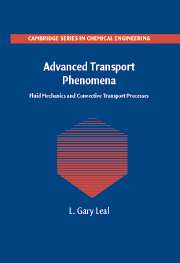Book contents
- Frontmatter
- Contents
- Preface
- Acknowledgments
- 1 A Preview
- 2 Basic Principles
- 3 Unidirectional and One-Dimensional Flow and Heat Transfer Problems
- 4 An Introduction to Asymptotic Approximations
- 5 The Thin-Gap Approximation – Lubrication Problems
- 6 The Thin-Gap Approximation – Films with a Free Surface
- 7 Creeping Flow – Two-Dimensional and Axisymmetric Problems
- 8 Creeping Flow – Three-Dimensional Problems
- 9 Convection Effects in Low-Reynolds-Number Flows
- 10 Laminar Boundary-Layer Theory
- 11 Heat and Mass Transfer at Large Reynolds Number
- 12 Hydrodynamic Stability
- Appendix A Governing Equations and Vector Operations in Cartesian, Cylindrical, and Spherical Coordinate Systems
- Appendix B Cartesian Component Notation
- Index
8 - Creeping Flow – Three-Dimensional Problems
Published online by Cambridge University Press: 05 June 2012
- Frontmatter
- Contents
- Preface
- Acknowledgments
- 1 A Preview
- 2 Basic Principles
- 3 Unidirectional and One-Dimensional Flow and Heat Transfer Problems
- 4 An Introduction to Asymptotic Approximations
- 5 The Thin-Gap Approximation – Lubrication Problems
- 6 The Thin-Gap Approximation – Films with a Free Surface
- 7 Creeping Flow – Two-Dimensional and Axisymmetric Problems
- 8 Creeping Flow – Three-Dimensional Problems
- 9 Convection Effects in Low-Reynolds-Number Flows
- 10 Laminar Boundary-Layer Theory
- 11 Heat and Mass Transfer at Large Reynolds Number
- 12 Hydrodynamic Stability
- Appendix A Governing Equations and Vector Operations in Cartesian, Cylindrical, and Spherical Coordinate Systems
- Appendix B Cartesian Component Notation
- Index
Summary
Although the solution methods of the preceding chapter are very useful and allowed us to derive a number of interesting results, they were all based on transforming the creeping-flow and continuity equations into a single higher-order differential for the streamfunction so that the classical methods of eigenfunction expansions can be used to obtain a general representation of the solution. This approach will work whenever the geometry of the boundaries and the form of any imposed flow are consistent with either a 2D or axisymmetric velocity and pressure field. We applied it to some representative 2D problems, as well as to problems involving the motions of spherical or near-spherical particles, bubbles, and drops in axisymmetric applied flows. There are, of course, other problems involving axisymmetric bodies in an axisymmetric flow – for example, any body of rotation in which the rotation axis is parallel to the axis of symmetry of the undisturbed flow. These problems can all be formulated in the same way, and, provided the geometry of the body is coincident with a coordinate surface in some orthogonal coordinate system, the same procedures can be followed.
In spite of the fact that there are actually quite a large number of axisymmetric problems, however, there are many important and apparently simple-sounding problems that are not axisymmetric.
- Type
- Chapter
- Information
- Advanced Transport PhenomenaFluid Mechanics and Convective Transport Processes, pp. 524 - 592Publisher: Cambridge University PressPrint publication year: 2007



